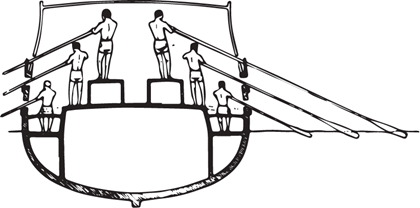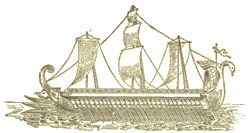Section of a Greek Trireme: The Athenian trireme was a ship having three banks of oars. The oarsmen were placed in tiers, the top row wielding the longest oars. The ship was about 115 feet long, with a height above water of 10 feet and a width across decks of 18 feet. Click here to enlarge. A trireme was a type of ancient Greek warship that played a crucial role in naval warfare during the classical period, particularly in the 5th and 4th centuries BCE. These vessels were characterized by their speed, agility, and distinctive design.
 Structure:
Structure:
- Size: A typical trireme was approximately 120 feet (36 meters) in length, with a relatively narrow beam (width) of around 18 feet (5.5 meters).
- Hull: The hull of a trireme was made of wood, primarily oak and pine. It featured a sleek, streamlined design with a shallow draft, allowing for swift movement through the water.
- Rowing Benches: The most distinctive feature of a trireme was the rowing benches. These vessels were propelled primarily by oars, with three banks of oars on each side, hence the name trireme. Each oar was handled by a single rower, and the banks were staggered to maximize the number of oars in the limited space.
Crew and Armament:
- Crew: A typical crew on a trireme included around 200 rowers, each responsible for a single oar, a few officers, a small group of marines or archers, and a helmsman. The rowers were often free citizens, and they played a crucial role in the ship's maneuverability.
- Ram: Triremes were equipped with a large bronze ram, known as a rostrum or "ramming prow," located at the front of the ship. The ram was designed to puncture and damage the hulls of enemy vessels during naval battles.
 Naval Warfare: Triremes were designed for naval combat. Their agility and speed allowed them to close in on enemy ships and use their rams effectively. The primary tactics in naval warfare involved ramming the enemy vessels and causing them to sink or become disabled.
Naval Warfare: Triremes were designed for naval combat. Their agility and speed allowed them to close in on enemy ships and use their rams effectively. The primary tactics in naval warfare involved ramming the enemy vessels and causing them to sink or become disabled.
Role in History--Battle of Salamis: One of the most famous uses of triremes was during the Battle of Salamis in 480 BCE, a key engagement in the Greco-Persian Wars. The Greek city-states, led by Athens, used triremes to defeat the much larger Persian fleet.
Legacy: Triremes represented a high point in ancient naval technology. They influenced the design of later warships and remained iconic vessels in the history of naval warfare.
Triremes were an integral part of the naval forces of ancient Greece, enabling them to assert their naval dominance in the Mediterranean and defend against external threats. Their design and capabilities made them a symbol of Greek naval prowess and contributed to the rich history of ancient Greek warfare.
|
 Structure:
Structure:
 Naval Warfare: Triremes were designed for naval combat. Their agility and speed allowed them to close in on enemy ships and use their rams effectively. The primary tactics in naval warfare involved ramming the enemy vessels and causing them to sink or become disabled.
Naval Warfare: Triremes were designed for naval combat. Their agility and speed allowed them to close in on enemy ships and use their rams effectively. The primary tactics in naval warfare involved ramming the enemy vessels and causing them to sink or become disabled. 













